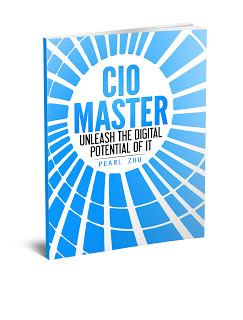Pearl Zhu's Blog, page 1296
September 17, 2016
The Monthly “CIO Master” Book Tuning: Accelerating Digital IT Leadership Maturity Sep. 2016
 The purpose of "CIO Master - Unleash the Digital Potential of IT " is to provide guidelines for building a framework to run a highly effective, highly innovative and highly mature digital IT organization. Also, it provides the principles to reinvent CIO leadership via practicing multitudes of digital influence. Here is the monthly “CIO Master” book tuning: Accelerate IT Leadership Maturity.
The purpose of "CIO Master - Unleash the Digital Potential of IT " is to provide guidelines for building a framework to run a highly effective, highly innovative and highly mature digital IT organization. Also, it provides the principles to reinvent CIO leadership via practicing multitudes of digital influence. Here is the monthly “CIO Master” book tuning: Accelerate IT Leadership Maturity.
Accelerating IT Digital Leadership Maturity Sep. 2016CIOs as Chief Improvement Officer: What are the signals of Dysfunctional IT Systems: Today’s organizations are far from perfect, there are ineffectiveness, dysfunction, overlapping, complication, silo, gaps, infighting, and inefficiencies, etc., all over the place. IT is at the unique position to oversee the underlying processes, build capabilities, and orchestrate the digital transformation, CIOs as IT leaders and Chief Improvement Officer: can you identify the signals of dysfunctional IT systems - not just through the symptoms on the surface, but digging into the root causes, and fix them smoothly to improve the business agility and maturity?
Raising the Profile of Digital CIOs: Contemporary digital CIOs wear multiple hats, play different roles with multiple personas. There is a distinct difference between a great CIO and an average CIO in terms of identifying and implementing competitive advantages and being a great leader. What are modern CIOs’ digital profile, and how can they improve leadership effectiveness and shift their role from transactional managers to transformational leaders.CIOs as VISIONEERs: Running Digital IT with "DECISIONEERING & SOLUTIONEERING & ENGINEERING" Disciplines: Forward-thinking IT organizations continue to reinvent themselves to improve efficiency, effectiveness, and agility. Ambitious companies also understand how crucial IT is to drive businesses growth and optimize business capabilities. Digital transformation is on the way. IT Transformation seeks to change. The word "transformation" in itself means change and change for the better - new ways and methods of doing things, new structures, new relationships etc. The contemporary CIOs are visioneers (visionary pioneers)- who can run digital IT with decisioneering, solutioneering, and engineering disciplines to improve organizational level effectiveness, intelligence, and maturity.
The CIO’s Situational Leadership for IT Digital Transformation Many IT organizations are on the inflection point for digital transformation, to transform from a cost center to a growth engine, from a back office function to a digital brain front yard, and from a help desk to an innovation hub. CIOs are wearing multiple hats, practice situational leadership to bridge the industrial age with the Digital Era, to focus on information management, process optimization, business innovation, and overall organizational maturity. Many think IT is shifting from a static function which is often controlling or even lagging behind the changes to a people-centric changing organization. Here are a couple of leadership and management roles CIOs need to balance well for improving IT efficiency, effectiveness, and agility.
 Practice CIO Plus Leadership to Run IT with “Enlightenment”: IT is moving up its maturity level from functioning to firm to delight. IT is neither luxury nor commodity, it's a competitive differentiator. With the new and disruptive technologies, CIOs need to change IT DNA from 'static" with change inertia to "dynamic" with change as a new normal; from a controller to an enabler, from "inside-out" operation driven to "outside-in" customer-centric. No more dictating technology solutions, but having a better understanding of the business and transforming IT to a business partner for providing business and customer driven solution.The “Future of CIO” Blog has reached 1.5 million page views with about #3100th blog posting in 59+ different categories of leadership, management, strategy, digitalization, change/talent, etc. The content richness is not for its own sake, but to convey the vision and share the wisdom. Blogging is not about writing, but about thinking and innovating the new ideas; it’s not just about WHAT to say, but about WHY to say, and HOW to say it. It reflects the color and shade of your thought patterns, and it indicates the peaks and curves of your thinking waves. Unlike pure entertainment, quality and professional content takes time for digesting, contemplation and engaging, and therefore, it takes time to attract the "hungry minds" and the "deep souls." It’s the journey to amplify diverse voices and deepen digital footprints, and it's the way to harness your innovative spirit.
Practice CIO Plus Leadership to Run IT with “Enlightenment”: IT is moving up its maturity level from functioning to firm to delight. IT is neither luxury nor commodity, it's a competitive differentiator. With the new and disruptive technologies, CIOs need to change IT DNA from 'static" with change inertia to "dynamic" with change as a new normal; from a controller to an enabler, from "inside-out" operation driven to "outside-in" customer-centric. No more dictating technology solutions, but having a better understanding of the business and transforming IT to a business partner for providing business and customer driven solution.The “Future of CIO” Blog has reached 1.5 million page views with about #3100th blog posting in 59+ different categories of leadership, management, strategy, digitalization, change/talent, etc. The content richness is not for its own sake, but to convey the vision and share the wisdom. Blogging is not about writing, but about thinking and innovating the new ideas; it’s not just about WHAT to say, but about WHY to say, and HOW to say it. It reflects the color and shade of your thought patterns, and it indicates the peaks and curves of your thinking waves. Unlike pure entertainment, quality and professional content takes time for digesting, contemplation and engaging, and therefore, it takes time to attract the "hungry minds" and the "deep souls." It’s the journey to amplify diverse voices and deepen digital footprints, and it's the way to harness your innovative spirit.
CIO Master Order Link on AmazonCIO Master Ordre Link on Barner & NobleCIO Master Order Link On IBooks“CIO Master” Book Preview Quote Collection III“CIO Master” Book Preview Quote Collection II“CIO Master” Book Preview Quote Collection I, Slideshare Presentation“CIO Master” Book Preview Conclusion Running IT as Digital Transformer“CIO Master” Book Preview: Chapter 9 IT Agility“CIO Master” Book Preview: Chapter 8 Three "P"s in Running Digital IT“CIO Master” Book Preview: Chapter 7 IT Innovation Management“CIO Master” Book Preview: Chapter 6 Digital Strategy-Execution Continuum"CIO Master” Book Preview: Chapter 5 Thirteen Digital Flavored IT“CIO Master” Book Preview: Chapter 4 CIO as Talent Master Introduction“CIO Master” Book Preview: Chapter 3 “CIOs as Change Agent” Introduction“CIO Master” Book Preview: Chapter 2 “CIOs as Digital Visionary” Introduction“CIO Master” Book Preview: Chapter 1 “Twelve Digital CIO Personas” Introduction"CIO Master - Unleash the Digital Potential of IT" Introduction
"CIO Master - Unleash the Digital Potential of IT" Book Preview
Follow us at: @Pearl_Zhu
Published on September 17, 2016 23:01
Three Characteristics of Digital Organizations
 Organizations large or small are on the journey of digital transformation. Digitalization implies the full-scale changes in the way the business is conducted so that simply adopting a new digital technology may not be insufficient. You have to transform the company's underlying functions, processes, and cultures, and organization as a whole with adjusted digital speed. Otherwise, companies may begin a decline from its previous good performance. More specifically, what are the characteristics of digital organizations, and can you make an objective self-assessment whether your organization is a digital master or a laggard?
Organizations large or small are on the journey of digital transformation. Digitalization implies the full-scale changes in the way the business is conducted so that simply adopting a new digital technology may not be insufficient. You have to transform the company's underlying functions, processes, and cultures, and organization as a whole with adjusted digital speed. Otherwise, companies may begin a decline from its previous good performance. More specifically, what are the characteristics of digital organizations, and can you make an objective self-assessment whether your organization is a digital master or a laggard?
Fluidity: Digital means flow, data flow, information flow, knowledge flow, mind flow, and business flow. Organizations, like individuals, need to be in flow to operate smoothly. From information management perspective, a high intellectual and high effective digital organization has a higher level of decision effectiveness because information can flow into the right people to allow them making right decisions at the right time to bring better result; from knowledge management perspective, Knowledge Management is a process to manage known from flowing. there is a shift from traditional, often static knowledge management approaches to techniques that involve enhancing the "flow" of knowledge within an organization to improve access and use. Knowledge is information put to use, The integration of Information Management and Knowledge Management will enable not only information flow and knowledge flow, but more importantly, it will empower mind flow, and business flow, to improve the business dynamic and agility. From organizational structure perspective, an organization achieves this state of equilibrium through its management layers. Delayering becomes a lens through which it is possible to examine and then fix many other issues. In other words, an organization can approach the flow zone when the positions in its hierarchy have clear, accountable tasks. The latest enterprise social platforms and collaboration tools make it practical to break down functional silos and improve cross-functional communication and collaboration.
Hyper-connectivity: Digital is about connectivity, it means to have the better ability for dots connection across the geographical or generational boundaries. Digital is also complex, it becomes complex if things do interact, particularly in the case of "non-linear" interaction, you can't separate things properly or you cannot predict the actual effect of interaction straightforwardly. Digital is the age of innovation, because creativity is about connecting the dots. How cleverly you connect your dots by leveraging your experiences and finding a solution to the problems is creativity which is also an important aspect of digital fluency. Creativity In life we come across various experiences (exposure to various situations) as wider dots, the more dots you have, the better chance your mind can connect them freely. Digital workforce today is also hyper-connected and divergent in many ways, share a natural affinity for new perspectives, innovations, and collective wisdom. Hyper-connectivity brings both the abundance of opportunities and unprecedented risks, hence, being connect-wise means to discern the trend from fads, seek business values before taking business initiatives, to build a high-innovative digital powerhouse.
 Complexity: Due to the “VUCA” nature of digitalization, business complexity is unavoidable. In fact, complexity has increased exponentially and has become the part of digital new normal. Imagine the complexity that comes in due to these characteristics (less structure, rules and regulations, diversity, volatility, ambiguity, unpredictability, lack of linearity and increased flux) working and impacting together. The complexity can be good or bad for businesses depending on your strategy and capability. There is no intelligence without the certain level of complexity, complexity is a property of intelligence. However, complication or unwanted complexity will stifle innovation and decrease productivity. From management perspective, typically look at complexity from a business impact perspective as well as from a solution perspective, complexity usually involves early in the life-cycle and careful examination of numbers and types of stakeholders across the organization; the extent to which the project is considered to be either strategic or tactical; the extent to which the project will change or transform (target end-state and impact) the business; numbers of external dependencies. Companies that are skilled at managing complexity can gain advantages by pushing the boundaries of a more sophisticated business mix that provides opportunities to create inter-business value, differentiated digital capabilities and the unique set of business competency.
Complexity: Due to the “VUCA” nature of digitalization, business complexity is unavoidable. In fact, complexity has increased exponentially and has become the part of digital new normal. Imagine the complexity that comes in due to these characteristics (less structure, rules and regulations, diversity, volatility, ambiguity, unpredictability, lack of linearity and increased flux) working and impacting together. The complexity can be good or bad for businesses depending on your strategy and capability. There is no intelligence without the certain level of complexity, complexity is a property of intelligence. However, complication or unwanted complexity will stifle innovation and decrease productivity. From management perspective, typically look at complexity from a business impact perspective as well as from a solution perspective, complexity usually involves early in the life-cycle and careful examination of numbers and types of stakeholders across the organization; the extent to which the project is considered to be either strategic or tactical; the extent to which the project will change or transform (target end-state and impact) the business; numbers of external dependencies. Companies that are skilled at managing complexity can gain advantages by pushing the boundaries of a more sophisticated business mix that provides opportunities to create inter-business value, differentiated digital capabilities and the unique set of business competency.
One of the key determinants of whether an organization can move to the digital new normal is the digital maturity of its people. If digital organization is a living body, so every individual is like an active cell to keep growing and flowing as well. So part of this journey is to prepare people for the new structures and to recognize this is a crucial step. People have to be ready for moving to a more fluid structure, hyperconnected status, and get used to the complex digital ecosystem, but follow the “Keep it Simple” principles to achieve digital equilibrium and achieve high-performing result.
Follow us at: @Pearl_Zhu
Published on September 17, 2016 22:54
September 16, 2016
The CIO's Digital Agenda: Running IT as a Digital Brain of the Organization Sep. 2016
Information Management is 'powerful' and 'worthy' to an organization and becomes the digital brain of an organization.
 Modern CIOs have many personas and face great challenges. It is not sufficient to only keep the light on. Regardless of which industry or the nature of organization you are in, being a digital leader will need to master the art of creating unique, differentiating value from piles of commoditized technologies. Digital transformation starts with mind shift, business value has to be driven, indicated and understood at all levels of the organization. This is accomplished by establishing strong interdependent relationships, the shared vision, and wisdom. But more specifically, what are the digital-savvy CIOs doing to make business information savvy in running IT as a digital brain of the organization.
Modern CIOs have many personas and face great challenges. It is not sufficient to only keep the light on. Regardless of which industry or the nature of organization you are in, being a digital leader will need to master the art of creating unique, differentiating value from piles of commoditized technologies. Digital transformation starts with mind shift, business value has to be driven, indicated and understood at all levels of the organization. This is accomplished by establishing strong interdependent relationships, the shared vision, and wisdom. But more specifically, what are the digital-savvy CIOs doing to make business information savvy in running IT as a digital brain of the organization.
Running IT as Digital Brain of the Organization Sep. 2016Running Digital IT with Highly Cognitive Connectivity? Digital is about flow, data flow, information flow, idea flow, and mind flow. IT organization today is like the digital brain of the organization, because information is used to educate, inform and provide decision making for people who use it; the business insight abstracted from information can help the business develop the next products or services to delight customers, predict future trends for exploring market share; as well as make data-based talent analysis to ensure the right people are in the right position with the right capabilities to solve the right business problems. To put briefly, running digital IT with highly cognitive connectivity will become a competitive advantage for building a high-intelligent and highly effective digital business?
Information Management as a Thresholding Competency of Digital IT Nowadays information is the lifeblood of the organization, all forward-looking organizations claim they are in the information management business, managing information and the information position of an organization is what ought to be called Information Management. Information Management is to make sure that the right information is in the right place at the right time and shared to the right persons for making the right decisions. IT is often the information steward of the business, and information management is a thresholding competency for running a digital IT.
INFORMATION-Driven IT is a Strategic Shift: The tension between 'business' and IT has been around forever, but instead of getting better, it has gotten worse in the last couple of years. The reason is that digital has become ’normality’, and almost everyone now feels at ease with digital technology. In other words, the natural knowledge advantage of the IT department has eroded. So what’s IT's digital advantage?
Information Management as Differentiator between Digital Master and Digital Laggard: Information is the most valuable commodity individuals and organizations produce in the digital environment in which they currently function. Nowadays, organizations large or small, collect an enormous amount of data. Data is a raw material, information is processed data, information only has a value when it is needed. When businesses manipulate information in meaningful ways which give you something to interpret and utilize, then you have established the value from the information you get. Therefore, Information Management is a key differentiator between digital master and digital Laggard?
 How Important an Information System can be in Digital Business Success? At industrial era, the majority of IT organizations are supporting function to keep the business light on; the cost center to maintain legacy applications & infrastructure; and the gatekeeper to control status quo. Nowadays IT and its value implication to the business have changed drastically; information becomes the lifeblood of digital business, and digital technology is lightweight but more powerful than ever. The question is –How important an information system can be in today, can you separate technology from an information system in order to achieve the intended results? And how to make Information Management as 'powerful' and 'worthy' to an organization as possible?
How Important an Information System can be in Digital Business Success? At industrial era, the majority of IT organizations are supporting function to keep the business light on; the cost center to maintain legacy applications & infrastructure; and the gatekeeper to control status quo. Nowadays IT and its value implication to the business have changed drastically; information becomes the lifeblood of digital business, and digital technology is lightweight but more powerful than ever. The question is –How important an information system can be in today, can you separate technology from an information system in order to achieve the intended results? And how to make Information Management as 'powerful' and 'worthy' to an organization as possible?
The “Future of CIO” Blog has reached 1.5 million page views with about #3100th blog posting in 59+ different categories of leadership, management, strategy, digitalization, change/talent, etc. The content richness is not for its own sake, but to convey the vision and share the wisdom. Blogging is not about writing, but about thinking and innovating the new ideas; it’s not just about WHAT to say, but about WHY to say, and HOW to say it. It reflects the color and shade of your thought patterns, and it indicates the peaks and curves of your thinking waves. Unlike pure entertainment, quality and professional content takes time for digesting, contemplation and engaging, and therefore, it takes time to attract the "hungry minds" and the "deep souls." It’s the journey to amplify diverse voices and deepen digital footprints, and it's the way to harness your innovative spirit.
Follow us at: @Pearl_Zhu
 Modern CIOs have many personas and face great challenges. It is not sufficient to only keep the light on. Regardless of which industry or the nature of organization you are in, being a digital leader will need to master the art of creating unique, differentiating value from piles of commoditized technologies. Digital transformation starts with mind shift, business value has to be driven, indicated and understood at all levels of the organization. This is accomplished by establishing strong interdependent relationships, the shared vision, and wisdom. But more specifically, what are the digital-savvy CIOs doing to make business information savvy in running IT as a digital brain of the organization.
Modern CIOs have many personas and face great challenges. It is not sufficient to only keep the light on. Regardless of which industry or the nature of organization you are in, being a digital leader will need to master the art of creating unique, differentiating value from piles of commoditized technologies. Digital transformation starts with mind shift, business value has to be driven, indicated and understood at all levels of the organization. This is accomplished by establishing strong interdependent relationships, the shared vision, and wisdom. But more specifically, what are the digital-savvy CIOs doing to make business information savvy in running IT as a digital brain of the organization.
Running IT as Digital Brain of the Organization Sep. 2016Running Digital IT with Highly Cognitive Connectivity? Digital is about flow, data flow, information flow, idea flow, and mind flow. IT organization today is like the digital brain of the organization, because information is used to educate, inform and provide decision making for people who use it; the business insight abstracted from information can help the business develop the next products or services to delight customers, predict future trends for exploring market share; as well as make data-based talent analysis to ensure the right people are in the right position with the right capabilities to solve the right business problems. To put briefly, running digital IT with highly cognitive connectivity will become a competitive advantage for building a high-intelligent and highly effective digital business?
Information Management as a Thresholding Competency of Digital IT Nowadays information is the lifeblood of the organization, all forward-looking organizations claim they are in the information management business, managing information and the information position of an organization is what ought to be called Information Management. Information Management is to make sure that the right information is in the right place at the right time and shared to the right persons for making the right decisions. IT is often the information steward of the business, and information management is a thresholding competency for running a digital IT.
INFORMATION-Driven IT is a Strategic Shift: The tension between 'business' and IT has been around forever, but instead of getting better, it has gotten worse in the last couple of years. The reason is that digital has become ’normality’, and almost everyone now feels at ease with digital technology. In other words, the natural knowledge advantage of the IT department has eroded. So what’s IT's digital advantage?
Information Management as Differentiator between Digital Master and Digital Laggard: Information is the most valuable commodity individuals and organizations produce in the digital environment in which they currently function. Nowadays, organizations large or small, collect an enormous amount of data. Data is a raw material, information is processed data, information only has a value when it is needed. When businesses manipulate information in meaningful ways which give you something to interpret and utilize, then you have established the value from the information you get. Therefore, Information Management is a key differentiator between digital master and digital Laggard?
 How Important an Information System can be in Digital Business Success? At industrial era, the majority of IT organizations are supporting function to keep the business light on; the cost center to maintain legacy applications & infrastructure; and the gatekeeper to control status quo. Nowadays IT and its value implication to the business have changed drastically; information becomes the lifeblood of digital business, and digital technology is lightweight but more powerful than ever. The question is –How important an information system can be in today, can you separate technology from an information system in order to achieve the intended results? And how to make Information Management as 'powerful' and 'worthy' to an organization as possible?
How Important an Information System can be in Digital Business Success? At industrial era, the majority of IT organizations are supporting function to keep the business light on; the cost center to maintain legacy applications & infrastructure; and the gatekeeper to control status quo. Nowadays IT and its value implication to the business have changed drastically; information becomes the lifeblood of digital business, and digital technology is lightweight but more powerful than ever. The question is –How important an information system can be in today, can you separate technology from an information system in order to achieve the intended results? And how to make Information Management as 'powerful' and 'worthy' to an organization as possible?The “Future of CIO” Blog has reached 1.5 million page views with about #3100th blog posting in 59+ different categories of leadership, management, strategy, digitalization, change/talent, etc. The content richness is not for its own sake, but to convey the vision and share the wisdom. Blogging is not about writing, but about thinking and innovating the new ideas; it’s not just about WHAT to say, but about WHY to say, and HOW to say it. It reflects the color and shade of your thought patterns, and it indicates the peaks and curves of your thinking waves. Unlike pure entertainment, quality and professional content takes time for digesting, contemplation and engaging, and therefore, it takes time to attract the "hungry minds" and the "deep souls." It’s the journey to amplify diverse voices and deepen digital footprints, and it's the way to harness your innovative spirit.
Follow us at: @Pearl_Zhu
Published on September 16, 2016 23:25
The “CIO Master” Monthly Tunings: Running IT as a Digital Brain of the Organization Sep. 2016
 Modern CIOs have many personas and face great challenges. It is not sufficient to only keep the light on. Regardless of which industry or the nature of organization you are in, being a digital leader will need to master the art of creating unique, differentiating value from piles of commoditized technologies. Digital transformation starts with mindshift, business value has to be driven, indicated and understood at all levels of the organization. This is accomplished by establishing strong interdependent relationships, the shared vision, and wisdom. But more specifically, what are the digital-savvy CIOs doing in running a digital-ready IT organization.
Modern CIOs have many personas and face great challenges. It is not sufficient to only keep the light on. Regardless of which industry or the nature of organization you are in, being a digital leader will need to master the art of creating unique, differentiating value from piles of commoditized technologies. Digital transformation starts with mindshift, business value has to be driven, indicated and understood at all levels of the organization. This is accomplished by establishing strong interdependent relationships, the shared vision, and wisdom. But more specifically, what are the digital-savvy CIOs doing in running a digital-ready IT organization.
Running IT as Digital Brain of the Organization Sep. 2016Running Digital IT with Highly Cognitive Connectivity? Digital is about flow, data flow, information flow, idea flow, and mind flow. IT organization today is like the digital brain of the organization, because information is used to educate, inform and provide decision making for people who use it; the business insight abstracted from information can help the business develop the next products or services to delight customers, predict future trends for exploring market share; as well as make data-based talent analysis to ensure the right people are in the right position with the right capabilities to solve the right business problems. To put briefly, running digital IT with highly cognitive connectivity will become a competitive advantage for building a high-intelligent and highly effective digital business?
Information Management as a Thresholding Competency of Digital IT Nowadays information is the lifeblood of the organization, all forward-looking organizations claim they are in the information management business, managing information and the information position of an organization is what ought to be called Information Management. Information Management is to make sure that the right information is in the right place at the right time and shared to the right persons for making the right decisions. IT is often the information steward of the business, and information management is a thresholding competency for running a digital IT.
INFORMATION-Driven IT is a Strategic Shift: The tension between 'business' and IT has been around forever, but instead of getting better, it has gotten worse in the last couple of years. The reason is that digital has become ’normality’, and almost everyone now feels at ease with digital technology. In other words, the natural knowledge advantage of the IT department has eroded. So what’s IT's digital advantage.
Information Management as Differentiator between Digital Master and Digital Laggard: Information is the most valuable commodity individuals and organizations produce in the digital environment in which they currently function. Nowadays, organizations large or small, collect an enormous amount of data. Data is a raw material, information is processed data, information only has a value when it is needed. When businesses manipulate information in meaningful ways which give you something to interpret and utilize, then you have established the value from the information you get. Therefore, Information Management is a key differentiator between digital master and digital Laggard?
 How Important an Information System can be in Digital Business Success? At industrial era, the majority of IT organizations are supporting function to keep the business light on; the cost center to maintain legacy applications & infrastructure; and the gatekeeper to control status quo. Nowadays IT and its value implication to the business have changed drastically; information becomes the lifeblood of digital business, and digital technology is lightweight but more powerful than ever. The question is –How important an information system can be in today, can you separate technology from an information system in order to achieve the intended results? And how to make Information Management as 'powerful' and 'worthy' to an organization as possible?
How Important an Information System can be in Digital Business Success? At industrial era, the majority of IT organizations are supporting function to keep the business light on; the cost center to maintain legacy applications & infrastructure; and the gatekeeper to control status quo. Nowadays IT and its value implication to the business have changed drastically; information becomes the lifeblood of digital business, and digital technology is lightweight but more powerful than ever. The question is –How important an information system can be in today, can you separate technology from an information system in order to achieve the intended results? And how to make Information Management as 'powerful' and 'worthy' to an organization as possible?The “Future of CIO” Blog has reached 1.5 million page views with about #3100th blog posting in 59+ different categories of leadership, management, strategy, digitalization, change/talent, etc. The content richness is not for its own sake, but to convey the vision and share the wisdom. Blogging is not about writing, but about thinking and innovating the new ideas; it’s not just about WHAT to say, but about WHY to say, and HOW to say it. It reflects the color and shade of your thought patterns, and it indicates the peaks and curves of your thinking waves. Unlike pure entertainment, quality and professional content takes time for digesting, contemplation and engaging, and therefore, it takes time to attract the "hungry minds" and the "deep souls." It’s the journey to amplify diverse voices and deepen digital footprints, and it's the way to harness your innovative spirit.
Follow us at: @Pearl_Zhu
Published on September 16, 2016 23:25
"CIO Master" Book Tuning #100: The CIO’s Situational Leadership for IT Digital Transformation
IT leaders have to practice transformational leadership, situational leadership, and innovative leadership all the way in order to lead digital transformation seamlessly.
 Many IT organizations are on the inflection point for digital transformation, to transform from a cost center to a growth engine, from a back office function to a digital brain front yard, and from a help desk to an innovation hub. CIOs are wearing multiple hats, practice situational leadership to bridge the industrial age with the Digital Era, to focus on information management, process optimization, business innovation, and overall organizational maturity. Many think IT is shifting from a static function which is often controlling or even lagging behind the changes to a people-centric changing organization. Here are a couple of leadership and management roles CIOs need to balance well for improving IT efficiency, effectiveness, and agility.
Many IT organizations are on the inflection point for digital transformation, to transform from a cost center to a growth engine, from a back office function to a digital brain front yard, and from a help desk to an innovation hub. CIOs are wearing multiple hats, practice situational leadership to bridge the industrial age with the Digital Era, to focus on information management, process optimization, business innovation, and overall organizational maturity. Many think IT is shifting from a static function which is often controlling or even lagging behind the changes to a people-centric changing organization. Here are a couple of leadership and management roles CIOs need to balance well for improving IT efficiency, effectiveness, and agility.
The CIO needs to know when to play as a transformational leader when to be a transactional manager: Forward-looking IT organizations need to contribute to the business’s strategic planning and drive digital transformation of the entire organization. As such, the CIO must be a strategic leader as their peer executive officers, understand the whole business models, customers, and the markets the business operates in, understand the competitive landscape, have a medium/long term investment and performance horizon in mind. Making sure that the money and resources being spent on IT is aligned with the long-term goals of the company and not just have fun with new technologies. CIOs do need to be tactical when necessary, being hands-on means CIOs shouldn't ignore key details or measure results, envisioning the future and seeing around the corner are both important -why, who, what, when, where, how., etc. CIOs should have the hands on key management processes that feed them the facts upon which to make better strategic decisions and measure how well they are doing. However, pay more attention to the pitfalls to act as a micromanager: Ineffective “hands-on” means they are interfering, meddling, tinkering or overbearing, undermining their people and therefore inhibiting the decision-making processes and stifling execution of the required deliverables. Most IT managers who progress through the ranks have a hard time letting go of what made them successful. But once they get passed that and learn to be strategic, they often have the ability to move back and forth as a transformational leader and tactical IT manager effectively.
The CIO needs to figure out when IT should be a rule maker, and when IT should take orders from customers: Traditional IT organizations only serve internal users and play a supporting role via taking order from customers. With the emergent digital technologies, the importance of IT organization is significantly increased, now many IT organizations also play a critical role in digitizing the touch points and improving the overall experience of the end customers. Changing IT away from an order taker role is more than about semantics. IT will always have a role doing internal support. The trick is separating the internal actions so they run in an auto mode, and letting the CIO focus on managing a portfolio of strategic projects that have a quantifiable business return. In order to run IT as a business partner, IT needs also to make policies for a smooth digital transformation. IT has the power to say “NO” to other internal business units if something is not in the best interest of the company. IT should also listen to both internal and end customers, and become an integral part of any business. Otherwise, the gaps between business and IT won’t be shrunk, and no wonder many IT organizations still get stuck at the lower level of maturity.
 CIOs in the well-established companies more often than not need to shift their management orientation and begin thinking like entrepreneurs: The mantra of digital IT organizations is “Running IT as a software Startup,” and “Doing more with innovation.” IT entrepreneurialism becomes a new fixture for management in their efforts to substantiate their competitive position, effect market landscape, and drive new revenue growth. The IT department should provide guidance, support, assistance and direction in the application and adoption of information technology solutions in support of business objectives! Today, IT is a competitive advantage for many successful businesses, the failure of IT will make the company suffer, or cause the business mighty fall. Hence, it's important in running IT as a business, set right KPIs to measure the level IT contribution. Take Operating expenses (normally where IT costs are collected) if IT part cost remains constant in terms of value compared to gross; IT is then contributing to productivity increase or top line business growth.
CIOs in the well-established companies more often than not need to shift their management orientation and begin thinking like entrepreneurs: The mantra of digital IT organizations is “Running IT as a software Startup,” and “Doing more with innovation.” IT entrepreneurialism becomes a new fixture for management in their efforts to substantiate their competitive position, effect market landscape, and drive new revenue growth. The IT department should provide guidance, support, assistance and direction in the application and adoption of information technology solutions in support of business objectives! Today, IT is a competitive advantage for many successful businesses, the failure of IT will make the company suffer, or cause the business mighty fall. Hence, it's important in running IT as a business, set right KPIs to measure the level IT contribution. Take Operating expenses (normally where IT costs are collected) if IT part cost remains constant in terms of value compared to gross; IT is then contributing to productivity increase or top line business growth.
IT has both gains and pains in leading digital transformation: On one side, it is a great opportunity for IT to reinvent its tarnished reputation to become a strategic partner of the business or a digital catalyzer; on the other side, there are still silo mentality, infighting, roadblocks, or pitfalls on the way. The pervasive digitization requires both business and technology professionals to rethink how things are done in organizations. The “reach and range” flexibility now exists removes barriers that have existed in the past. And IT leaders have to practice transformational leadership, situational leadership and innovative leadership all the way.
Follow us at: @Pearl_Zhu
 Many IT organizations are on the inflection point for digital transformation, to transform from a cost center to a growth engine, from a back office function to a digital brain front yard, and from a help desk to an innovation hub. CIOs are wearing multiple hats, practice situational leadership to bridge the industrial age with the Digital Era, to focus on information management, process optimization, business innovation, and overall organizational maturity. Many think IT is shifting from a static function which is often controlling or even lagging behind the changes to a people-centric changing organization. Here are a couple of leadership and management roles CIOs need to balance well for improving IT efficiency, effectiveness, and agility.
Many IT organizations are on the inflection point for digital transformation, to transform from a cost center to a growth engine, from a back office function to a digital brain front yard, and from a help desk to an innovation hub. CIOs are wearing multiple hats, practice situational leadership to bridge the industrial age with the Digital Era, to focus on information management, process optimization, business innovation, and overall organizational maturity. Many think IT is shifting from a static function which is often controlling or even lagging behind the changes to a people-centric changing organization. Here are a couple of leadership and management roles CIOs need to balance well for improving IT efficiency, effectiveness, and agility.
The CIO needs to know when to play as a transformational leader when to be a transactional manager: Forward-looking IT organizations need to contribute to the business’s strategic planning and drive digital transformation of the entire organization. As such, the CIO must be a strategic leader as their peer executive officers, understand the whole business models, customers, and the markets the business operates in, understand the competitive landscape, have a medium/long term investment and performance horizon in mind. Making sure that the money and resources being spent on IT is aligned with the long-term goals of the company and not just have fun with new technologies. CIOs do need to be tactical when necessary, being hands-on means CIOs shouldn't ignore key details or measure results, envisioning the future and seeing around the corner are both important -why, who, what, when, where, how., etc. CIOs should have the hands on key management processes that feed them the facts upon which to make better strategic decisions and measure how well they are doing. However, pay more attention to the pitfalls to act as a micromanager: Ineffective “hands-on” means they are interfering, meddling, tinkering or overbearing, undermining their people and therefore inhibiting the decision-making processes and stifling execution of the required deliverables. Most IT managers who progress through the ranks have a hard time letting go of what made them successful. But once they get passed that and learn to be strategic, they often have the ability to move back and forth as a transformational leader and tactical IT manager effectively.
The CIO needs to figure out when IT should be a rule maker, and when IT should take orders from customers: Traditional IT organizations only serve internal users and play a supporting role via taking order from customers. With the emergent digital technologies, the importance of IT organization is significantly increased, now many IT organizations also play a critical role in digitizing the touch points and improving the overall experience of the end customers. Changing IT away from an order taker role is more than about semantics. IT will always have a role doing internal support. The trick is separating the internal actions so they run in an auto mode, and letting the CIO focus on managing a portfolio of strategic projects that have a quantifiable business return. In order to run IT as a business partner, IT needs also to make policies for a smooth digital transformation. IT has the power to say “NO” to other internal business units if something is not in the best interest of the company. IT should also listen to both internal and end customers, and become an integral part of any business. Otherwise, the gaps between business and IT won’t be shrunk, and no wonder many IT organizations still get stuck at the lower level of maturity.
 CIOs in the well-established companies more often than not need to shift their management orientation and begin thinking like entrepreneurs: The mantra of digital IT organizations is “Running IT as a software Startup,” and “Doing more with innovation.” IT entrepreneurialism becomes a new fixture for management in their efforts to substantiate their competitive position, effect market landscape, and drive new revenue growth. The IT department should provide guidance, support, assistance and direction in the application and adoption of information technology solutions in support of business objectives! Today, IT is a competitive advantage for many successful businesses, the failure of IT will make the company suffer, or cause the business mighty fall. Hence, it's important in running IT as a business, set right KPIs to measure the level IT contribution. Take Operating expenses (normally where IT costs are collected) if IT part cost remains constant in terms of value compared to gross; IT is then contributing to productivity increase or top line business growth.
CIOs in the well-established companies more often than not need to shift their management orientation and begin thinking like entrepreneurs: The mantra of digital IT organizations is “Running IT as a software Startup,” and “Doing more with innovation.” IT entrepreneurialism becomes a new fixture for management in their efforts to substantiate their competitive position, effect market landscape, and drive new revenue growth. The IT department should provide guidance, support, assistance and direction in the application and adoption of information technology solutions in support of business objectives! Today, IT is a competitive advantage for many successful businesses, the failure of IT will make the company suffer, or cause the business mighty fall. Hence, it's important in running IT as a business, set right KPIs to measure the level IT contribution. Take Operating expenses (normally where IT costs are collected) if IT part cost remains constant in terms of value compared to gross; IT is then contributing to productivity increase or top line business growth.
IT has both gains and pains in leading digital transformation: On one side, it is a great opportunity for IT to reinvent its tarnished reputation to become a strategic partner of the business or a digital catalyzer; on the other side, there are still silo mentality, infighting, roadblocks, or pitfalls on the way. The pervasive digitization requires both business and technology professionals to rethink how things are done in organizations. The “reach and range” flexibility now exists removes barriers that have existed in the past. And IT leaders have to practice transformational leadership, situational leadership and innovative leadership all the way.
Follow us at: @Pearl_Zhu
Published on September 16, 2016 23:19
The CIO’s Situational Leadership for IT Digital Transformation
 Many IT organizations are on the inflection point for digital transformation, to transform from a cost center to a growth engine, and from a help desk to an innovation hub. CIOs are also wearing multiple hats, practice situational leadership to bridge the industrial age with the Digital Era, to focus on information management, process optimization, business innovation, and many think IT is shifting from a static support function to a people-centric changing organization. Here are a couple of leadership and management roles CIOs need to balance well to improve IT efficiency, effectiveness, and agility.
Many IT organizations are on the inflection point for digital transformation, to transform from a cost center to a growth engine, and from a help desk to an innovation hub. CIOs are also wearing multiple hats, practice situational leadership to bridge the industrial age with the Digital Era, to focus on information management, process optimization, business innovation, and many think IT is shifting from a static support function to a people-centric changing organization. Here are a couple of leadership and management roles CIOs need to balance well to improve IT efficiency, effectiveness, and agility.
The CIO needs to know when to play as a transformational leader, when to be a transactional manager: Forward-looking IT organizations need to contribute to the business’s strategic planning and drive digital transformation of the organization. As such, the CIO must be a strategic leader as their peer executive officers must be, understand the whole business model, customers, and the markets the business operates in, understand the competitive landscape, have a medium/long term investment and performance horizon in mind. Making sure that the money and resources being spent on IT is aligned with the long term goals of the company and not just have fun with new technologies. CIOs do need to be tactical when necessary, being hands-on means CIOs shouldn't ignore key details or measure results, envisioning the future and seeing around the corner are both important -why, who, what, when, where, how., etc. CIOs should have hands on the key management processes that feed them the facts upon which to make better strategic decisions and measure how well they are doing. However, pay more attention to the pitfalls to be a micromanager. Ineffective “hands-on” means they are interfering, meddling, tinkering or overbearing, undermining their people and therefore inhibiting the decision making processes and stifling execution of the required deliverables. Most IT managers who progress through the ranks have a hard time letting go of what made them successful. But once they get passed that and learn to be strategic, they often have the ability to move back and forth as a transformational leader and tactical IT manager effectively.
The CIO also need to figure out when should IT be a rule maker, and when should IT take orders from customers: Traditional IT organizations only serve internal users and play a supporting role via taking order from customers. But now many IT organizations also play a critical role in digitizing the touch points and improving the experience of the end customers. Changing IT away from the order taker role is more than about semantics. IT will always have a role doing internal support. The trick is separating the internal actions so they run in an auto mode, and having the CIO focus on managing a portfolio of strategic projects that have a quantifiable business return. In order to run IT as a business partner, IT needs also to make policies for a smooth digital transformation. IT has the power to say “NO” to other internal business units if something is not in the best interest of the company. IT should also listen to both internal and end customers, and become an integral part of any business. Otherwise, the gaps between business and IT won’t shrinked, and no wonder many IT organizations still get stuck at the lower level of maturity.
 CIOs in the well-established companies more often than not need to shift their management orientation and begin thinking like entrepreneurs: The mantra of digital IT organizations is “Running IT as a software Startup,” and “Doing more with innovation.” IT intrapreneurialism becomes a new fixture for management in their efforts to substantiate their competitive position, effect market landscape, and drive new revenue growth. The IT department should provide guidance, support, assistance and direction in the application and adoption of information technology solutions in support of business objectives! Today IT is competitive advantage for many successful business, the failure of IT will make the business suffer, or cause the business mighty fall. Running IT as a business, set right KPIs to measure the level IT contribution. Take Operating expenses (normally where IT costs are collected) if IT part cost remains constant in terms of value compared to gross; IT is then contributing to productivity increase.
CIOs in the well-established companies more often than not need to shift their management orientation and begin thinking like entrepreneurs: The mantra of digital IT organizations is “Running IT as a software Startup,” and “Doing more with innovation.” IT intrapreneurialism becomes a new fixture for management in their efforts to substantiate their competitive position, effect market landscape, and drive new revenue growth. The IT department should provide guidance, support, assistance and direction in the application and adoption of information technology solutions in support of business objectives! Today IT is competitive advantage for many successful business, the failure of IT will make the business suffer, or cause the business mighty fall. Running IT as a business, set right KPIs to measure the level IT contribution. Take Operating expenses (normally where IT costs are collected) if IT part cost remains constant in terms of value compared to gross; IT is then contributing to productivity increase.
IT has both gains and pains in leading digital transformation: one one side, it is a great opportunity for IT to reinvent its tarnished reputation to become a strategic partner of the business; on the other side, there are still silo mentality, infighting, roadblocks, or pitfalls on the way. Hene, the pervasive digitization requires both business and technology professionals to rethink how things are done in organizations. The “reach and range” flexibility that now exists removes barriers that have existed in the past. And IT leaders have to practice transformational leadership, situational leadership and innovation leadership all the way.
Follow us at: @Pearl_Zhu
Published on September 16, 2016 23:19
September 15, 2016
The Weekly Insight of the “Future of CIO” 9/15/ 2016
 The “Future of CIO” Blog has reached 1.5 million page views with 3100+ blog posting in 59+ different categories of leadership, management, strategy, digitalization, change/talent, etc. The content richness is not for its own sake, but to convey the vision and share the wisdom. Here is the weekly insight about digital leadership, IT Management, and Talent Management.
The “Future of CIO” Blog has reached 1.5 million page views with 3100+ blog posting in 59+ different categories of leadership, management, strategy, digitalization, change/talent, etc. The content richness is not for its own sake, but to convey the vision and share the wisdom. Here is the weekly insight about digital leadership, IT Management, and Talent Management.
The Weekly Insight of the “Future of CIO” 9/15/2016Raising the Profile of Digital CIOs: Contemporary digital CIOs wear multiple hats, play different roles with multiple personas. There is a distinct difference between a great CIO and an average CIO in terms of identifying and implementing competitive advantages and being a great leader. What are modern CIOs’ digital profile, and how can they improve leadership effectiveness and shift their role from transactional managers to transformational leaders
Three Digital Tilts for Talent Management Innovation: People are always the most valuable asset in any business in the past, today, and future. The focal point for talent management does shift from managing people as cost & resource to asset and human capital. In essence, the business is running by people (employees) for the people (customers), and digital is the age of people. The question is how to develop, assess and motivate your people, and put the right people in the right position with the right capability to solve the right problems? There are three modern tilts for talent management and performance management innovation.
The New Book “Digitizing Boardroom” Monthly Tuning Slideshare Presentation: Modern corporate boards play significant roles in guiding businesses toward the right direction and achieve expected business results. Due to the “VUCA” characteristics -Complexity, Uncertainty, Ambiguity and Velocity of the Digital Era, the directorship in any organization must have the agility to adapt to changes, and build abilities to advise, inspire and motivate a group of people toward accomplishing shared visions and goals.
 Running Digital IT with Highly Cognitive Connectivity? Digital is about flow, data flow, information flow, idea flow, and mind flow. IT organization today is like the digital brain of the organization, because information is used to educate, inform and provide decision making for people who use it; the business insight abstracted from information can help the business develop the next products or services to delight customers, predict future trends for exploring market share; as well as make data-based talent analysis to ensure the right people are in the right position with the right capabilities to solve the right business problems. To put briefly, running digital IT with highly cognitive connectivity will become a competitive advantage for building a high-intelligent and highly effective digital business? The Monthly Foresight: The Future of Organizations Sep. 2016: The new paradigm that is emerging is one as a Living Organization or Digital Workplace, which is organic, alive, holistic, vibrant, energetic, responsive, fluid, creative and innovative, in a relationship with its environment/customers/ suppliers, and above all enhances and supports the dignity of the creative human spirit. One of the major themes of the "Future of CIO" blog is to envision and brainstorming the FUTURE, to bridge the siloed industrial age with the hyperconnected Digital Era, and to share the world-class leadership and management insight. Here comes the monthly foresight of "All about Future": What will be the Future of Organizations? What's your ideal digital workforce and workplace? Is future already here or still far away?? Blogging is not about writing, but about thinking and innovating the new ideas; it’s not just about WHAT to say, but about WHY to say, and HOW to say it. It reflects the color and shade of your thought patterns, and it indicates the peaks and curves of your thinking waves. Unlike pure entertainment, quality and professional content takes time for digesting, contemplation and engaging, and therefore, it takes the time to attract the "hungry minds" and the "deep souls." It’s the journey to amplify diverse voices and deepen digital footprints, and it's the way to harness your innovative spirit.
Running Digital IT with Highly Cognitive Connectivity? Digital is about flow, data flow, information flow, idea flow, and mind flow. IT organization today is like the digital brain of the organization, because information is used to educate, inform and provide decision making for people who use it; the business insight abstracted from information can help the business develop the next products or services to delight customers, predict future trends for exploring market share; as well as make data-based talent analysis to ensure the right people are in the right position with the right capabilities to solve the right business problems. To put briefly, running digital IT with highly cognitive connectivity will become a competitive advantage for building a high-intelligent and highly effective digital business? The Monthly Foresight: The Future of Organizations Sep. 2016: The new paradigm that is emerging is one as a Living Organization or Digital Workplace, which is organic, alive, holistic, vibrant, energetic, responsive, fluid, creative and innovative, in a relationship with its environment/customers/ suppliers, and above all enhances and supports the dignity of the creative human spirit. One of the major themes of the "Future of CIO" blog is to envision and brainstorming the FUTURE, to bridge the siloed industrial age with the hyperconnected Digital Era, and to share the world-class leadership and management insight. Here comes the monthly foresight of "All about Future": What will be the Future of Organizations? What's your ideal digital workforce and workplace? Is future already here or still far away?? Blogging is not about writing, but about thinking and innovating the new ideas; it’s not just about WHAT to say, but about WHY to say, and HOW to say it. It reflects the color and shade of your thought patterns, and it indicates the peaks and curves of your thinking waves. Unlike pure entertainment, quality and professional content takes time for digesting, contemplation and engaging, and therefore, it takes the time to attract the "hungry minds" and the "deep souls." It’s the journey to amplify diverse voices and deepen digital footprints, and it's the way to harness your innovative spirit.Follow us at: @Pearl_Zhu
Published on September 15, 2016 23:32
To Celebrate Full Moon Day: Three Pillars in Building the World-class Insight
Misunderstanding is the big cause of many human problems, hence, insight is the light we should pursue for.
 It is another mid-autumn moon festival and the time to celebrate the full moon day. We humans share the same sun, the same moon, the same set of stars and the same nature resources, but can we or shall we share the common insight or set the similar standards, even though we speak the different languages, or have different customs? Beauty is in the eyes of the beholders, but insight can be shared to connect the minds and touch the hearts without the border. So the world- class insight, do you have one, and what are important pillars to build it?
It is another mid-autumn moon festival and the time to celebrate the full moon day. We humans share the same sun, the same moon, the same set of stars and the same nature resources, but can we or shall we share the common insight or set the similar standards, even though we speak the different languages, or have different customs? Beauty is in the eyes of the beholders, but insight can be shared to connect the minds and touch the hearts without the border. So the world- class insight, do you have one, and what are important pillars to build it?
Cognition: Misunderstanding is the big cause of many human problems, hence, insight is the light we should pursue for. Insight can only be captured via cognitive minds with multidimensional intelligence. The most important capability of cognitive mind is the willingness and ability to seek out acknowledge, gain in-depth understanding, and address our ignorance and the assumptions we make to minimize it. Insight is the act or result of understanding the inner nature of situations or of seeing things intuitively. It leads to a vision; then leads to the paradigm shift, strategic changes, or leadership transformation. Knowledge is concrete, and intelligence is contextual. At today’s digital world, logic is often nonlinear and multidimensional, hence, the minds with tunnel vision have difficulties in catching the world-class insight. Fortunately, nowadays new technologies and social media platforms are driving an unprecedented reorganization of how we produce and create knowledge and share wisdom to overcome common challenges and discover insight and solutions. Amplified by a new level of collective intelligence and tapping resources embedded in social connections with multitudes of others, we can now achieve the kind of scale and reach previously attainable only by very large organizations do. When in-depth thoughts and understanding transcend into insight, better at the world-class level, the optimal solution to a specific problem can be scaled and applied to other domains; the mindsets with the cognitive difference can be connected seamlessly and the hearts can be touched via positive emotion flows, and insight becomes the common sense to advance the society.
Abstraction: Specialization divides, but abstraction bridges. Abstraction is being able to step back from details and see patterns, generalization, standards, context, and a bigger picture, and then the insight is emerging via multilevel of understanding. Through content understanding, we turn on our imagination and knowledge that we have to decode the thought hidden not only in the message as itself but also in another mind, with the goal to enforce understanding in a structural and scientific way. The abstraction helps us reach the point of agreement which could be reached, and then you can elaborate via decomposition, specialization, inclusion, or realization until you reach a point of disagreement, always open your minds, listen carefully, first understand, and then being understood, keep capturing the flash of new insight, gaining the in-depth understanding of things underneath, and always pursue the premium solutions for the long run.
 Profundity: Insight is not just about “seeing,” but through sophisticated thought processes. In fact, it can leverage multiple thinking processes in dealing with varying situations wisely. In order to “see” things differently and understand them profoundly, you need to leverage critical thinking which is the mental process of actively and skillfully conceptualizing, applying, analyzing, synthesizing, and evaluating information to reach an answer or conclusion. In order to see broadly and the big picture, you have to apply creative thinking and systems thinking as well in order to connect the nonlinear dots and see the interconnected relationship between parts and whole. To put briefly, insight comes via the perception that is based on one’s thought processes influenced by one’s thinking style, cognitive understanding, and knowledge level. A profound mind is like a big ocean, deep, but also open. A profound mind is humble enough to be aware of and admit what you don't know and share what you know. The point is that the more you know, the more you know you don’t know and admit unknown unknown, the more insightful you become, to be open minded with learning agility.
Profundity: Insight is not just about “seeing,” but through sophisticated thought processes. In fact, it can leverage multiple thinking processes in dealing with varying situations wisely. In order to “see” things differently and understand them profoundly, you need to leverage critical thinking which is the mental process of actively and skillfully conceptualizing, applying, analyzing, synthesizing, and evaluating information to reach an answer or conclusion. In order to see broadly and the big picture, you have to apply creative thinking and systems thinking as well in order to connect the nonlinear dots and see the interconnected relationship between parts and whole. To put briefly, insight comes via the perception that is based on one’s thought processes influenced by one’s thinking style, cognitive understanding, and knowledge level. A profound mind is like a big ocean, deep, but also open. A profound mind is humble enough to be aware of and admit what you don't know and share what you know. The point is that the more you know, the more you know you don’t know and admit unknown unknown, the more insightful you become, to be open minded with learning agility.
Life is just like the moon, there are moments of full and wax, the clear insight is perhaps just like the moonlight lucidity, make you keep pondering, not just jump to the conclusion; observe remotely, and feel cool, calm and unique inside...Follow us at: @Pearl_Zhu
 It is another mid-autumn moon festival and the time to celebrate the full moon day. We humans share the same sun, the same moon, the same set of stars and the same nature resources, but can we or shall we share the common insight or set the similar standards, even though we speak the different languages, or have different customs? Beauty is in the eyes of the beholders, but insight can be shared to connect the minds and touch the hearts without the border. So the world- class insight, do you have one, and what are important pillars to build it?
It is another mid-autumn moon festival and the time to celebrate the full moon day. We humans share the same sun, the same moon, the same set of stars and the same nature resources, but can we or shall we share the common insight or set the similar standards, even though we speak the different languages, or have different customs? Beauty is in the eyes of the beholders, but insight can be shared to connect the minds and touch the hearts without the border. So the world- class insight, do you have one, and what are important pillars to build it?
Cognition: Misunderstanding is the big cause of many human problems, hence, insight is the light we should pursue for. Insight can only be captured via cognitive minds with multidimensional intelligence. The most important capability of cognitive mind is the willingness and ability to seek out acknowledge, gain in-depth understanding, and address our ignorance and the assumptions we make to minimize it. Insight is the act or result of understanding the inner nature of situations or of seeing things intuitively. It leads to a vision; then leads to the paradigm shift, strategic changes, or leadership transformation. Knowledge is concrete, and intelligence is contextual. At today’s digital world, logic is often nonlinear and multidimensional, hence, the minds with tunnel vision have difficulties in catching the world-class insight. Fortunately, nowadays new technologies and social media platforms are driving an unprecedented reorganization of how we produce and create knowledge and share wisdom to overcome common challenges and discover insight and solutions. Amplified by a new level of collective intelligence and tapping resources embedded in social connections with multitudes of others, we can now achieve the kind of scale and reach previously attainable only by very large organizations do. When in-depth thoughts and understanding transcend into insight, better at the world-class level, the optimal solution to a specific problem can be scaled and applied to other domains; the mindsets with the cognitive difference can be connected seamlessly and the hearts can be touched via positive emotion flows, and insight becomes the common sense to advance the society.
Abstraction: Specialization divides, but abstraction bridges. Abstraction is being able to step back from details and see patterns, generalization, standards, context, and a bigger picture, and then the insight is emerging via multilevel of understanding. Through content understanding, we turn on our imagination and knowledge that we have to decode the thought hidden not only in the message as itself but also in another mind, with the goal to enforce understanding in a structural and scientific way. The abstraction helps us reach the point of agreement which could be reached, and then you can elaborate via decomposition, specialization, inclusion, or realization until you reach a point of disagreement, always open your minds, listen carefully, first understand, and then being understood, keep capturing the flash of new insight, gaining the in-depth understanding of things underneath, and always pursue the premium solutions for the long run.
 Profundity: Insight is not just about “seeing,” but through sophisticated thought processes. In fact, it can leverage multiple thinking processes in dealing with varying situations wisely. In order to “see” things differently and understand them profoundly, you need to leverage critical thinking which is the mental process of actively and skillfully conceptualizing, applying, analyzing, synthesizing, and evaluating information to reach an answer or conclusion. In order to see broadly and the big picture, you have to apply creative thinking and systems thinking as well in order to connect the nonlinear dots and see the interconnected relationship between parts and whole. To put briefly, insight comes via the perception that is based on one’s thought processes influenced by one’s thinking style, cognitive understanding, and knowledge level. A profound mind is like a big ocean, deep, but also open. A profound mind is humble enough to be aware of and admit what you don't know and share what you know. The point is that the more you know, the more you know you don’t know and admit unknown unknown, the more insightful you become, to be open minded with learning agility.
Profundity: Insight is not just about “seeing,” but through sophisticated thought processes. In fact, it can leverage multiple thinking processes in dealing with varying situations wisely. In order to “see” things differently and understand them profoundly, you need to leverage critical thinking which is the mental process of actively and skillfully conceptualizing, applying, analyzing, synthesizing, and evaluating information to reach an answer or conclusion. In order to see broadly and the big picture, you have to apply creative thinking and systems thinking as well in order to connect the nonlinear dots and see the interconnected relationship between parts and whole. To put briefly, insight comes via the perception that is based on one’s thought processes influenced by one’s thinking style, cognitive understanding, and knowledge level. A profound mind is like a big ocean, deep, but also open. A profound mind is humble enough to be aware of and admit what you don't know and share what you know. The point is that the more you know, the more you know you don’t know and admit unknown unknown, the more insightful you become, to be open minded with learning agility. Life is just like the moon, there are moments of full and wax, the clear insight is perhaps just like the moonlight lucidity, make you keep pondering, not just jump to the conclusion; observe remotely, and feel cool, calm and unique inside...Follow us at: @Pearl_Zhu
Published on September 15, 2016 23:29
Three Pillars in Word-class Insight to Celebrate Full Moon Day
 It is another mid-autumn moon festival and the time to celebrate the full moon day. We humans share the same sun, the same moon, the same set of stars and the same nature resources, but can we or shall we share the common insight or set the similar standards, even though we speak the different languages, or have different customs? Beauty is in the eyes of the beholders, but insight can connect the minds and touch the hearts. The world- class insight, do you have one, and what are important pillars to build it?
It is another mid-autumn moon festival and the time to celebrate the full moon day. We humans share the same sun, the same moon, the same set of stars and the same nature resources, but can we or shall we share the common insight or set the similar standards, even though we speak the different languages, or have different customs? Beauty is in the eyes of the beholders, but insight can connect the minds and touch the hearts. The world- class insight, do you have one, and what are important pillars to build it?
Cognition: Misunderstanding is the big cause of many human problems. The most important capability of cognitive mind is the willingness and ability to seek out acknowledge, gain in-depth understanding to capture the world class insight, and address our ignorance and the assumptions we make to minimize it. Insight is the act or result of understanding the inner nature of situations or of seeing things intuitively. It leads to a vision; then leads to the paradigm shift, strategic changes, or business transformation. Knowledge is concrete, and intelligence is contextual. At today’s digital world, logic is often nonlinear and multidimensional. New technologies and social media platforms are driving an unprecedented reorganization of how we produce and create knowledge and share wisdom to overcome common challenges and discover solutions. Amplified by a new level of collective intelligence and tapping resources embedded in social connections with multitudes of others, we can now achieve the kind of scale and reach previously attainable only by very large organizations do. When in-depth thoughts and understanding transcend into insight, better at the world class level, the good solution to a specific problem can be scaled and applied to other domains; the mindsets with the cognitive difference can be connected seamlessly and the hearts can be touched via positive emotion flows.
Abstraction: Specialization divides, but abstraction bridges. Abstraction is being able to step back from details and see patterns, generalization, standards, context, and a bigger picture. Through content understanding, we turn on our imagination and knowledge that we have to decode the thought hidden not only in the message as itself but also in another mind, with the goal to enforce understanding in a structural and scientific way. The abstraction helps us reach the point of agreement which could be reached, and then you can elaborate via decomposition, specialization, inclusion, or realization until you reach a point of disagreement, always open your minds, listen carefully, first understand, and then being understood, keep capturing the flash of new insight, and gaining the in-depth understanding of things underneath, and always pursue the premium solutions for the long run.
 Profundity: Insight is not just about “seeing,” but through sophisticated thought processes. In fact, it can leverage multiple thinking processes in dealing with varying situations wisely. In order to “see” things differently and understand them profoundly, you need to leverage critical thinking which is the mental process of actively and skillfully conceptualizing, applying, analyzing, synthesizing, and evaluating information to reach an answer or conclusion. In order to see broadly and the big picture, you have to apply creative thinking and systems thinking as well in order to connect the nonlinear dots and see the interconnected relationship between parts and whole. To put briefly, insight comes via perception that is based on one’s thought processes influenced by one’s thinking style, cognitive understanding, and knowledge level. A profound mind is like a big ocean, deep, but also open. A profound mind is humble enough to be aware of and admit what you don't know and share what you know. The point is that the more you know, the more you know you don’t know and admit unknown unknown, the more insightful you become, to be open minded with learning agility.
Profundity: Insight is not just about “seeing,” but through sophisticated thought processes. In fact, it can leverage multiple thinking processes in dealing with varying situations wisely. In order to “see” things differently and understand them profoundly, you need to leverage critical thinking which is the mental process of actively and skillfully conceptualizing, applying, analyzing, synthesizing, and evaluating information to reach an answer or conclusion. In order to see broadly and the big picture, you have to apply creative thinking and systems thinking as well in order to connect the nonlinear dots and see the interconnected relationship between parts and whole. To put briefly, insight comes via perception that is based on one’s thought processes influenced by one’s thinking style, cognitive understanding, and knowledge level. A profound mind is like a big ocean, deep, but also open. A profound mind is humble enough to be aware of and admit what you don't know and share what you know. The point is that the more you know, the more you know you don’t know and admit unknown unknown, the more insightful you become, to be open minded with learning agility. Life is just like the moon, there are both moments of full and wax, the clear insight is perhaps just like the moonlight lucidity, make you keep pondering, not just jump to the conclusion; observe remotely, and feel cool, calm and unique inside...Follow us at: @Pearl_Zhu
Published on September 15, 2016 23:29
CIOs as Chief Improvement Officer: What are the signals of Dysfunctional IT Systems
 Today’s organizations are far from perfect, there are ineffectiveness, dysfunction, overlapping, complication, silo, gaps, infighting, and inefficiencies, etc., all over the place, IT is at the unique position to oversee the underlying process and orchestrate the digital transformation, CIOs as IT leaders and Chief Improvement Officer: can you identify the signals of dysfunctional IT systems - not just the symptom on the surface, but digging into the root cause , and how to fix them to improve the business agility and maturity.
Today’s organizations are far from perfect, there are ineffectiveness, dysfunction, overlapping, complication, silo, gaps, infighting, and inefficiencies, etc., all over the place, IT is at the unique position to oversee the underlying process and orchestrate the digital transformation, CIOs as IT leaders and Chief Improvement Officer: can you identify the signals of dysfunctional IT systems - not just the symptom on the surface, but digging into the root cause , and how to fix them to improve the business agility and maturity.
When systems control the circumstances, not people, you know it doesn’t mean the system is superior, but very possible it’s broken: When service professionals want to help customers, but they complain: The system doesn’t allow me to do so.” It is the signal that something is wrong. Dysfunction, complication, rigidity, and inefficiencies are not always easy to uncover. It takes processes, methodology, and practices to identify the causes of IT ineffectiveness and inefficiency. In most cases, you don't understand your business environment because you have never looked outside the problems boundary. The first step when thinking about a system is to understand the purpose of the containing system. It means looking out of problems before looking into the problems. What Russ Ackoff used to call "looking out of the problem" as opposed to "looking into the problem.” That is the synthesis before analysis. When the system problems goes beyond the technique issues only, if, and when you ever develop the capacity for synthesis, you will discover the containing system has social, ecological, economic and political elements and you must advance the development of all of these factors in order to solve the problems in a holistic way and improve organizational maturity seamlessly.
You can tell that the system has problems when it is stifling innovation and decrease productivity: When people are not working via the system to solve the real problems but play the system to stifle innovation or create the “comfort zone” to stop changes, you know that there is the problem. The elements of an outdated system are built using out-of-favor or at least depreciated tools, running on out-of-favor platforms, or documentation not matching the actual system. The bad systems are also possibly caused by complicated processes or unnecessary complexity. Those elements suggest you'll have a hard time finding people who can, or want to, work on the system; that your platforms won't be robust or stable enough to support growth and change; and that the cost of understanding the cost/risk of a change will be high. When productivity is low, the further analytics is needed for understanding the cause, whether it is due to the “hard” systems broken, change curve, inefficient practice/ process, or the “soft” culture complacency. The key issue is whether management recognizes a need for improvement and will support both the changes and the necessary change management and training/orientation. The key factor is to maintain acceptable productivity during any potentially disruptive change process, and always encourage creativity and enable innovation.
 You know the systems are “bad” when they beat good people every time. Either IT or the business system as a whole, are the means to the end, not the end itself. The high performing information system should provide the right information to the right people to make effective decisions at the right time. When systems are bad, the silo thinking is propagating, the business and IT gaps are enlarged, and functional walls go up because the systems measure individual or departmental outcomes, rather than the business as a whole. When the performance system is “bad,” because you see mediocrity get rewards, and innovation gets punished, In other words, what are the organization's rewards and recognition structure perpetuating? Differentiated performance metrics and rewards systems tend to bring this shift in perspective about, but they too are a necessary aspect of how an organization operates until they become counter-productive and have to be changed. A the saying goes, “a bad system will beat a good person every time.”
You know the systems are “bad” when they beat good people every time. Either IT or the business system as a whole, are the means to the end, not the end itself. The high performing information system should provide the right information to the right people to make effective decisions at the right time. When systems are bad, the silo thinking is propagating, the business and IT gaps are enlarged, and functional walls go up because the systems measure individual or departmental outcomes, rather than the business as a whole. When the performance system is “bad,” because you see mediocrity get rewards, and innovation gets punished, In other words, what are the organization's rewards and recognition structure perpetuating? Differentiated performance metrics and rewards systems tend to bring this shift in perspective about, but they too are a necessary aspect of how an organization operates until they become counter-productive and have to be changed. A the saying goes, “a bad system will beat a good person every time.”
There are many signs about a dysfunctional system, you just need to have the insightful eyes to identify them. Generally speaking, the limitations of the systems start to show and they are no longer able to accommodate changing needs, overly rigid to protect silos, and outdated to keep things simple. On the opposite, the good systems enable changes, empower users and talented employees, self-adaptable to meet the business needs and build a solid foundation to catalyze digital transformation.
Follow us at: @Pearl_Zhu
Published on September 15, 2016 23:23



